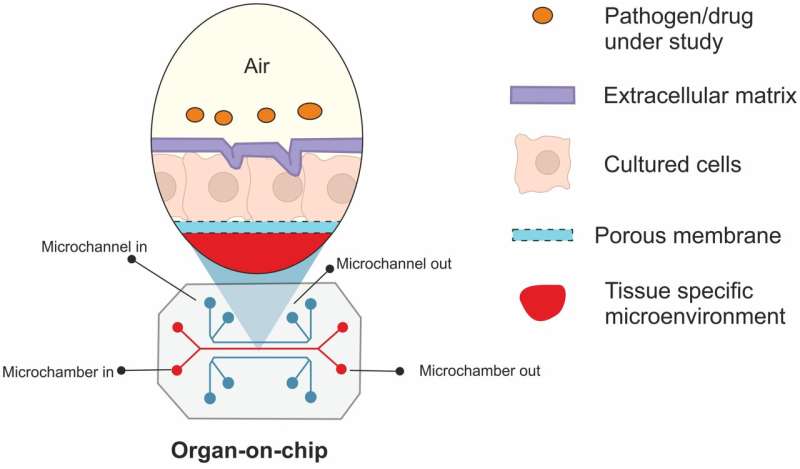This article has been reviewed according to Science X's editorial process and policies. Editors have highlighted the following attributes while ensuring the content's credibility:
fact-checked
proofread
Organs-on-chips provide insights into molecular mechanisms of disease, facilitate design of newer treatment strategies

Organs-on-chips (OoCs) represent a revolutionary advancement in the study of human physiology and disease, offering an in vitro microphysiological environment that mimics the functions of human organs. These devices combine cell biology and engineering to create a platform that supports the growth and function of cells outside the human body. A comprehensive review, published in the Journal of Exploratory Research in Pharmacology, explores the current state of OoC technology, its applications, challenges, and future prospects in drug development, disease modeling, and personalized medicine.
OoCs are classified into single, double, or multichannel chips. Double-channel chips feature two separate channels connected by a porous membrane, allowing the study of interactions between different cell types within the same tissue. These systems include inlets and outlets for the perfusion of culture media, mimicking the natural environment of human tissues.
The ability of OoCs to replicate human organ functions provides valuable insights into the molecular mechanisms of diseases. By simulating the physiological conditions of human tissues, OoCs facilitate the study of disease progression and the effects of therapeutic interventions. This technology has been particularly effective in modeling complex organs such as the liver, brain, and blood system.
The liver, essential for various physiological processes and drug metabolism, can be severely affected by adverse drug reactions. Traditional in vivo models often fail to predict these toxic effects accurately. Liver-on-chip models, which culture liver cells on a microfluidic chip, have shown promise in predicting hepatotoxicity and improving the safety profile of new drugs.
Brain-on-chip technology employs multi-step lithography to create models that replicate the brain's microenvironment. These models are crucial for studying neurodegenerative diseases and the regenerative capacity of neural tissues. The technology enables high-throughput screening of experimental treatments and provides insights into the brain's complex cellular interactions.
Replicating the human circulatory system is challenging due to its complexity. Blood-on-chip models incorporate various blood components, such as white and red blood cells, platelets, and plasma, to study their interactions and the immune response. These models are constructed using polydimethylsiloxane (PDMS) and are critical for understanding hematological disorders and developing new treatments.
Pancreatic cancer remains one of the most difficult cancers to treat due to its invasive nature and resistance to conventional therapies. Pancreas-on-chip models have been developed to study the interaction between cancerous and normal pancreatic cells, providing a platform to test new anticancer drugs and improve treatment strategies.
OoCs are transforming drug development by providing a more accurate representation of human tissue responses compared to traditional animal models. These devices enable the testing of drug efficacy and safety at various stages of development, potentially reducing the time and cost associated with bringing new drugs to market. Additionally, OoCs offer a platform for personalized medicine, where treatments can be tailored to the specific needs of individual patients.
Despite their potential, OoCs face several challenges, including the complexity of accurately replicating human physiology and the need for standardization across different models. Future research should focus on improving the scalability and reproducibility of OoC systems. Collaboration between academic institutions, industry, and regulatory agencies will be crucial in advancing this technology and integrating it into mainstream biomedical research and health care.
Organs-on-chips represent a significant leap forward in biomedical research, offering new insights into human physiology and disease mechanisms. By accurately mimicking the microenvironment of human tissues, OoCs provide a powerful tool for drug development, disease modeling, and personalized medicine. Continued advancements in this technology hold the promise of transforming health care and improving patient outcomes.
More information: Smita Nayak et al, Organs-on-chips Provide Insights into Molecular Mechanisms of Disease and Facilitate the Design of Newer Treatment Strategies: A Concise Review, Journal of Exploratory Research in Pharmacology (2024). DOI: 10.14218/JERP.2023.00006S





















